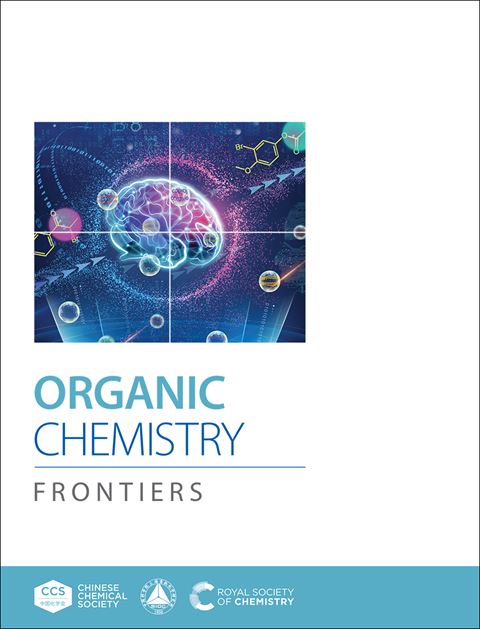手性双膦-一氧化二氢-金(I)配合物使β-萘酚衍生物发生不对称脱芳环化
IF 4.7
1区 化学
Q1 CHEMISTRY, ORGANIC
引用次数: 0
摘要
手性膦配体在金(I)催化的不对称反应中起着关键作用,但它们的有效性往往受到手性诱导策略的限制。传统的配体主要依赖于空间效应,而Au(I)中心的线性几何要求创新的配体设计能够超越空间障碍的协同相互作用。这一挑战激发了结合互补弱配位基的配体的发展,以增强对映体的控制。本文报道了四种新型手性金(I)配合物,包括(R)-BINAP(O)-AuCl 3a, (R)-MeO-BiPhep(O)-AuCl 3b, (S)-SegPhos(O)-AuCl 3c和(R,R)-DuPhos(O)-AuCl 3d,它们是由市售的双膦配体通过单氧化和Au(I)-络合得到的。对这些配合物在β-萘酚衍生物分子内催化不对称脱芳(CADA)反应中的催化作用进行了评价,其中配合物3a [(R)-BINAP(O)-AuCl]表现出优异的催化性能,以中高的对映体过剩率生成了一系列螺-萘酮产物。实验和计算研究表明,3a中的P=O部分促进了与底物的关键氢键相互作用,与Au(I)-炔配位协同作用,使过渡态固化,增强了立体控制。本研究建立了手性BPMO-Au(I)配合物作为不对称脱芳化的多功能催化剂,具有可扩展性和对各种β-萘酚底物的适用性。本文章由计算机程序翻译,如有差异,请以英文原文为准。
Chiral Bis-Phosphine Monoxide-Gold(I) Complex Enables Asymmetric Dearomative Cyclization of β-Naphthol Derivatives
Chiral phosphine ligands play a pivotal role in gold(I)-catalyzed asymmetric reactions, yet their efficacy is often constrained by limited strategies for chiral induction. While traditional ligands rely primarily on steric effects, the linear geometry of Au(I) centers demands innovative ligand designs capable of synergistic interactions beyond spatial hindrance. This challenge motivates the development of ligands incorporating supplementary weakly coordinating groups to enhance enantiocontrol. We herein report four novel chiral Gold(I) complexes based on bis-phosphine monoxide ligands (BPMOs), including (R)-BINAP(O)-AuCl 3a, (R)-MeO-BiPhep(O)-AuCl 3b, (S)-SegPhos(O)-AuCl 3c and (R,R)-DuPhos(O)-AuCl 3d, derived from commercially available biphosphine ligands via mono-oxidation and Au(I)-complexation. The catalytic utility of these complexes was evaluated in the intramolecular catalytic asymmetric dearomatization (CADA) reaction of β-naphthol derivatives, among which, complex 3a [(R)-BINAP(O)-AuCl] exhibited superior performance, delivering a series of spiro-naphthalenone products in good yields with moderate to high enantiomeric excess. Experimental and computational studies reveal that the P=O moiety in 3a facilitates a critical hydrogen-bonding interaction with the substrate, synergizing with Au(I)-alkyne coordination to rigidify the transition state and amplify stereocontrol. This work establishes chiral BPMO-Au(I) complexes as versatile catalysts for asymmetric dearomatization, with demonstrated scalability and applicability to diverse β-naphthol substrates.
求助全文
通过发布文献求助,成功后即可免费获取论文全文。
去求助
来源期刊

Organic Chemistry Frontiers
CHEMISTRY, ORGANIC-
CiteScore
7.90
自引率
11.10%
发文量
686
审稿时长
1 months
期刊介绍:
Organic Chemistry Frontiers is an esteemed journal that publishes high-quality research across the field of organic chemistry. It places a significant emphasis on studies that contribute substantially to the field by introducing new or significantly improved protocols and methodologies. The journal covers a wide array of topics which include, but are not limited to, organic synthesis, the development of synthetic methodologies, catalysis, natural products, functional organic materials, supramolecular and macromolecular chemistry, as well as physical and computational organic chemistry.
 求助内容:
求助内容: 应助结果提醒方式:
应助结果提醒方式:


